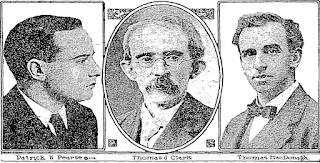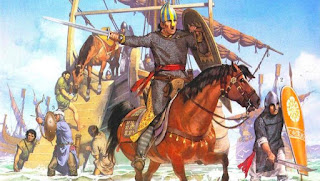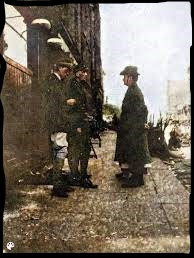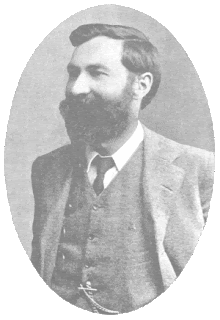1 May 1169: This is the date traditionally assigned to mark the beginning of the Anglo Norman Invasion of Ireland by military forces drawn from England & Wales. The genesis of the Expedition was the bid by Diarmait Mac Murchada the deposed king of the province of Leinster to win back his kingdom. To do this he needed help from abroad as he knew he could not hope to succeed against the combined armies of - Rory O’Connor/Ruaidhrí Ó Conchobhair -the High King/Ard Rí of Ireland.
King Diarmait left Ireland in late 1166 to seek help in England from King Henry II. However he was not just king of England but also Duke of Normandy and held extensive territories in France that he was constantly called upon to tour in order to maintain his patchwork Empire. When Diarmait finally caught up with him in France he won his backing on condition that he be Henry’s man - i.e. he recognised Henry as his Overlord. Presumably he would have secured a Charter to carry with him to produce in front of the men of England to show that he had Royal Assent for his raising of Mercenaries in that Country. His efforts met with success.
Thus it came about that in May of 1169 a force from England landed at Bannow Bay Wexford under the command of Robert Fitzstephen - whose own mother Nesta was a Lady of Wales. These forerunners of the English Forces of eight and a half centuries consisted of approximately 30 knights, 60 other horsemen and some 300 archers & footmen. Maurice de Prendergast from Wales arrived the following day with another 10 knights and 60 archers. They weren't of course all ‘English’ as they were would have been many Welsh -esp. the archers - in their ranks and quite possibly some real ‘Normans’ too - but to the Gaels of Ireland they were ‘the English’.
It was a good place to land as it was on King Diarmait’s home turf. It was also within striking distance of two of Ireland’s most important ports - the Norse held towns of Wexford and Waterford. King Diarmait was already back in Ireland by this stage and after a period of operating incognito had shown his hand and had raised a force to dispute with the High King his claim to re take his seat as king of Leinster. He even had a small force of mercenaries with him that he paid out of his own resources. He sent one of his own sons with a force of 500 men to rendezvous with these outside reinforcements and with the combined force Diarmait then advanced and layed siege to Wexford. After initially being repulsed, they forced the Wexfordmen to submit. By prior terms the town and the lands around it were granted to Fitzstephen and de Prendergast.
Then Robert the son of Stephen
Got himself ready the first;
He wished to cross over to Ireland
In order to aid King Dermot.
Brave knights of great renown
He brought with him, nine or ten.
One was Meiler the son of Henry,
Who was very powerful;
And Miles came there also
The son of the bishop of St. Davids.
Knights came there and barons
Whose names for the most part I do not know.
There crossed over a baron
With seven companions,
Maurice de Prendergast was his name,
As the song tells us.
Hervey too, in truth, crossed over,
He was of Mount-Maurice.
About three hundred crossed over
Knights and common folk besides.
At Bannow they landed
With all their men.
When they had landed
And had all disembarked,
They made their men encamp
On the sea-shore.
The English folk sent word
To King Dermot by messenger
That at Bannow with three ships
They had at that time landed,
And that the king should speedily
Come there without delay.
Song of Dermot and the Earl
Thus Fortune, constant only in her instability, almost deserted not only MacMurchad, but Fitzstephen also. However on the following morning, after Mass had been celebrated throughout the Army, they proceeded to renew the assault with more circumspection and order, relying on their skill as well as their courage, and when they drew near to the walls the townsmen despairing of being able to defend them and reflecting that they were disloyally resisting their Prince sent envoys Dermitius [Diarmait] commissioned to treat of the terms of Peace. At length by the mediation of two bishops who chanced to be in town at the time, and other worthy and peaceable men peace was restored, the townsmen submitting to Dermitius and delivering four of their chief men as hostages for their fealty to him. And the more to animate the courage of his adherents and reward their chiefs for their first success he forthwith granted the town with the whole territory appertaining to it to Fitzstephen and Maurice according to the stipulations in their original Treaty.
Expugnatio Hibernica by Giraldus Cambrenus
So these arrivals did not want a payment in specie for their efforts but wished to be rewarded with lands and towns and cities of their own which must of course be at the expense of those who already held them - i.e. lands either granted to them by Diarmait from those of his underlings or taken at the expense of their common enemies in the rest of Ireland. This was the root of the idea of the Conquest in the eyes of the men who made it - to usurp the Irish kings and rule in their stead. From such small beginnings emanated many great and bloody events in the History of Ireland.
* Illustration by Angus McBride












